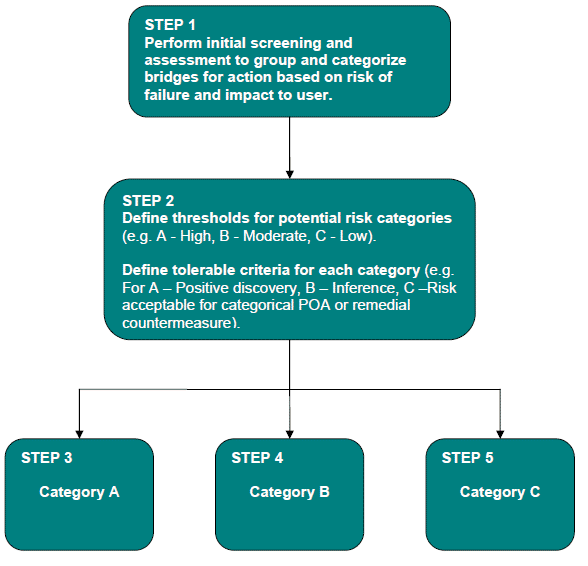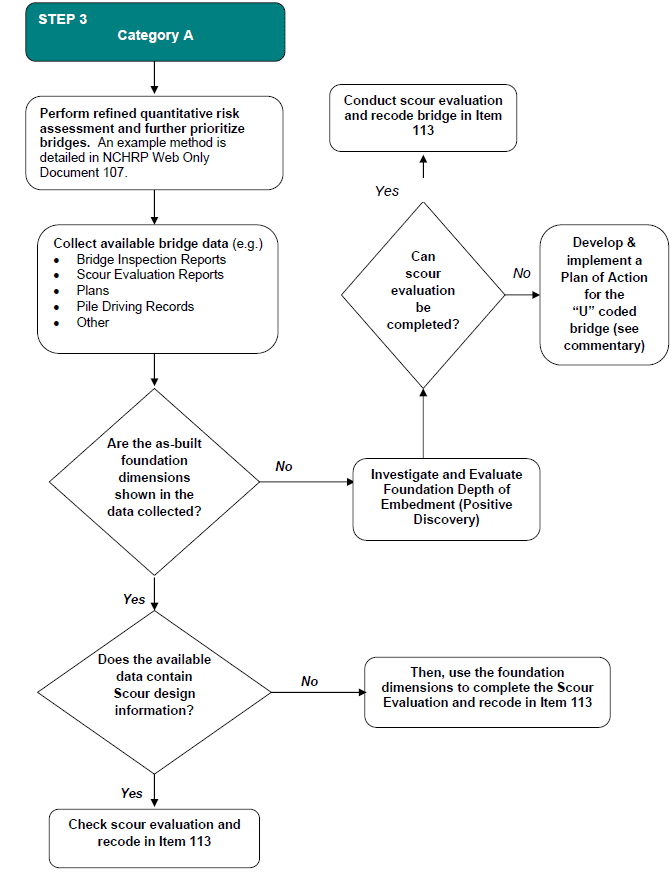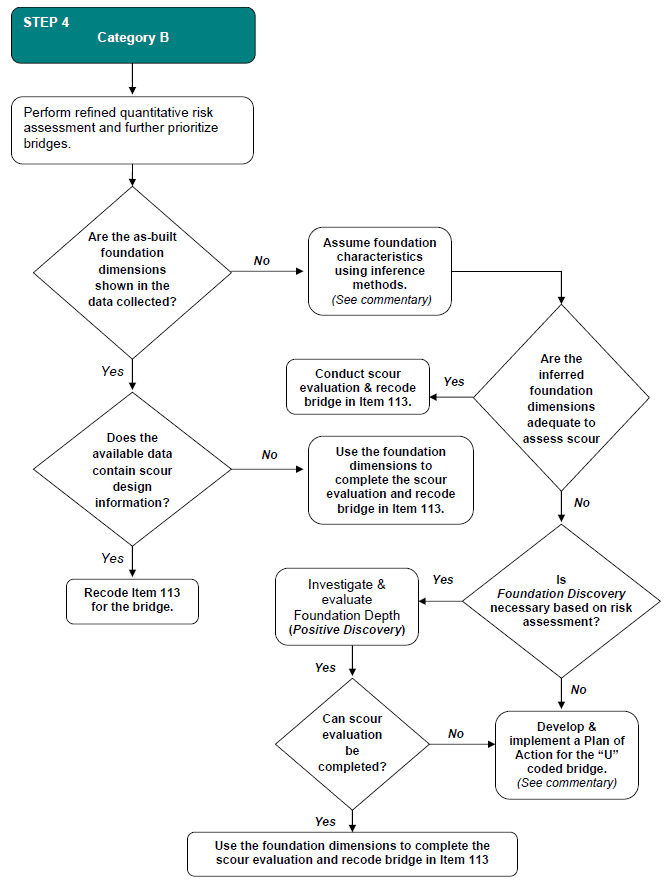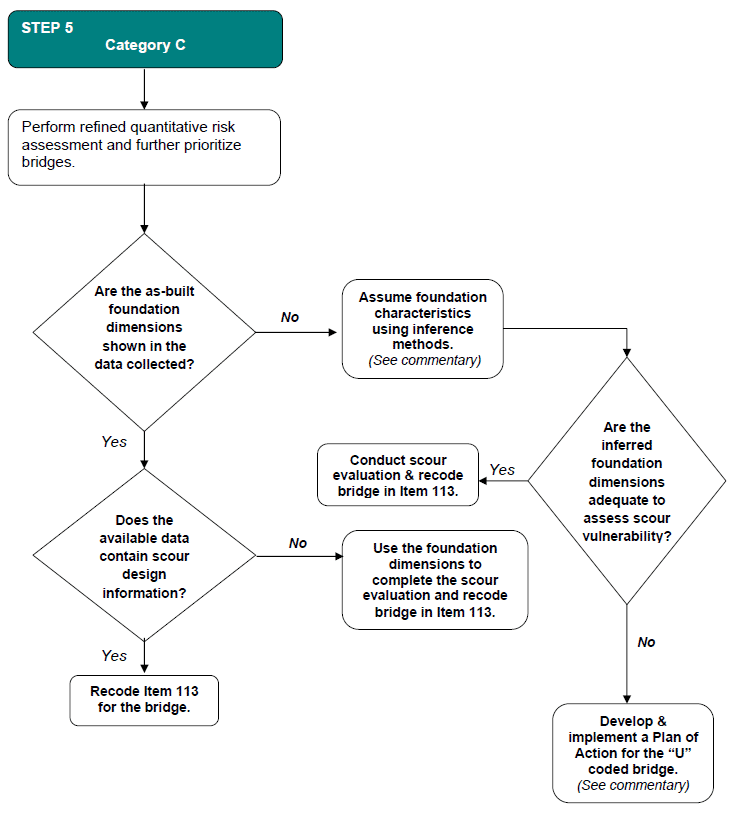Attachment "A"
Attachment "A" - Example Risk-Based Assessment for Bridges with Unknown Foundations with Commentary

*Note: Refer to Commentary for more complete flowchart descriptions.



Commentary
Example Risk-Based Assessment for Bridges with Unknown Foundations
NOTE: This commentary is meant to be used with the example flow chart for risk-based assessment for bridges with unknown foundations. The accompanying flow charts presented by FHWA are provided as example guidance for conducting a risk-based assessment for determining the necessary foundation characteristics for conducting a scour evaluation. It is the responsibility of the bridge owners and agencies that maintain their bridge inventories to manage the population of bridges coded "U" for Item 113 of the NBI.
Owners should understand that there are several approaches that have been implemented for assessing unknown bridge foundations, and for conducting scour evaluations on bridges with unknown foundations. Owners should evaluate and select assessment and evaluation approaches after careful consideration of their bridge inventory.
Step 1
The intent of this first step is to confirm that bridges coded "U" are coded correctly and to group bridges into categories for prioritization and action. This effort should consider replacement schedule and cost, structure type (e.g. simple span), hydrology, geomorphology, and estimated storm and scour effects. This action was presented in our January 9, 2008 memorandum and should be underway or complete for most bridge owners.
In addition, the owner should consider using easily obtainable and reliable indicators for this purpose. Information contained in the NBI may be used for this purpose, including but not limited to the following:
- Functional Classification of Inventory Route (Item 26);
- Bypass, Detour Length (Item 19);
- Designated Level of Service (Item 5c)
- Year Built (Item 27);
- Average Daily Traffic (Item 29);
- Year of Average Daily Traffic (Item 30);
- Navigation Clearances (Items 39 & 40);
- Condition Ratings (Items 58-62);
- Waterway Adequacy (Item 71);
- STRAHNET Highway Designation (Item 100);
- Average Daily Truck Traffic (Item 109); and
- Designated National Network (Item 110).
A relative numeric rating system is an example of a simplified approach to readily distinguish and group bridges for further action. Indicators of risk can be defined, rated individually or in aggregate, weighted according to their perceived significance, and summed in some fashion to get the numeric rating. Alternatively, a more rigorous risk-based approach may be used for initial categorization, and subsequent refined assessment of scour failure risk. An example of a relatively rigorous approach is detailed in NCHRP Web Only Document 107; however numerous examples of risk-based approaches are identified in literature. Please refer to the reference list for risk-based management on the Unknown Foundations website.
Step 2
Thresholds will need to be established in order to distinguish relative risk and to establish a corresponding protocol. FHWA should work with bridge owners in identifying how risk and threshold levels could be defined; however, determination of relative risk and thresholds levels must be established by the bridge owners.
Bridges should be grouped into categories corresponding to risk. For the accompanying flow-chart, categories corresponding to A - High, B - Moderate and C - Low are shown. Additional categories may be assigned to allow further categorization and prioritization based on readily inferred conditions and observed performance during a major event. For example, a category might be created for simple-span structures of low risk with a designated plan of action (POA).
Step 3
Category A is limited by owner-defined acceptable or tolerable risk criteria. For the example flowchart presented, Category A bridges represent a high risk, and are restricted to positive discovery of foundation characteristics necessary for scour evaluation. For bridges in this category, owners will need to establish means for positively identifying foundation type, location and depth such that a scour evaluation for the bridge can be conducted. This may involve invasive techniques, such as test pits, or non destructive evaluation techniques.
Step 4
Category B is limited by owner-defined acceptable or tolerable risk criteria. For the example flowchart presented, Category B bridges represent a moderate risk. For this category, risk-based assessments to infer or assume necessary foundation characteristics for scour evaluation are allowed. Inferences and assumptions must be justified within an acceptable degree of engineering confidence for the purposes of scour evaluation.
For bridges in this category, if the degree of confidence for inference or assumption is not high enough to warrant recoding the bridge from "U" in Item 113, a decision will need to be made by the owner to require positive discovery of the necessary foundation characteristics or to develop and implement an appropriate POA.
Step 5
Category C is limited by owner-defined acceptable or tolerable risk criteria. For the example flowchart presented, Category C bridges represent a low risk. For this category, risk-based assessments to infer or assume necessary foundation characteristics for scour evaluation are allowed. Inferences and assumptions must be justified within an acceptable degree of engineering confidence for the purposes of scour evaluation.
For bridges in this category, if the degree of confidence for inference or assumption is not high enough to warrant recoding, a POA will need to be developed and implemented.
Determination of Foundation Characteristics Using Inference Methods
For bridges not grouped or categorized as high risk, it may be more cost-effective and efficient for owners to use alternate methods for inferring foundation characteristics necessary for scour evaluation. An example of an inference method is considering known foundations of similar bridges in age, construction, geology or location, and inferring that if the bridges are similar, the foundations are as well. The Unknown Foundations Website is being populated with a number of examples for assessing unknown bridge foundations without going through positive discovery using NDT, borings or test pits.
Bridge owners should evaluate inference methods carefully prior to use to ensure that risk potential for the bridge is adequately quantified and addressed.
Plans of Action for Bridges with Unknown Foundations
FHWA has previously provided guidance for owners on how to develop and implement a POA for scour critical bridges. An owner has a few options for development of a POA for bridges with unknown foundations and additional guidance is presented in Appendix "B."

